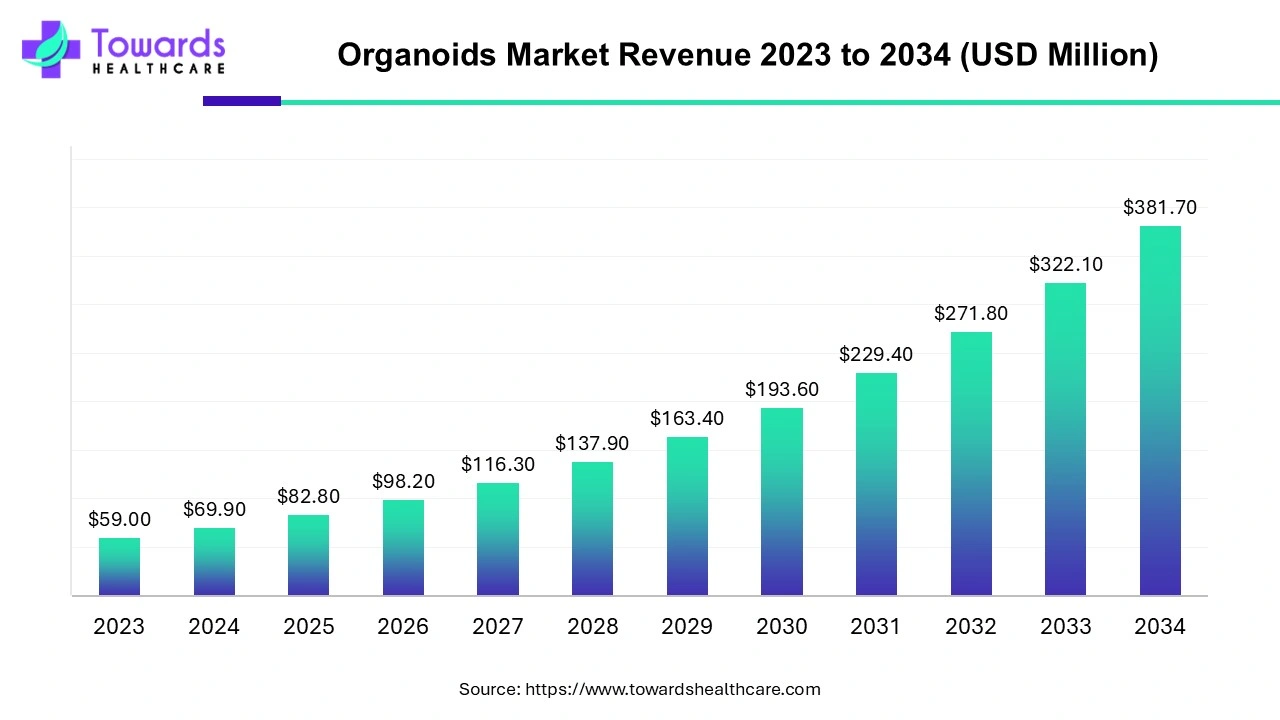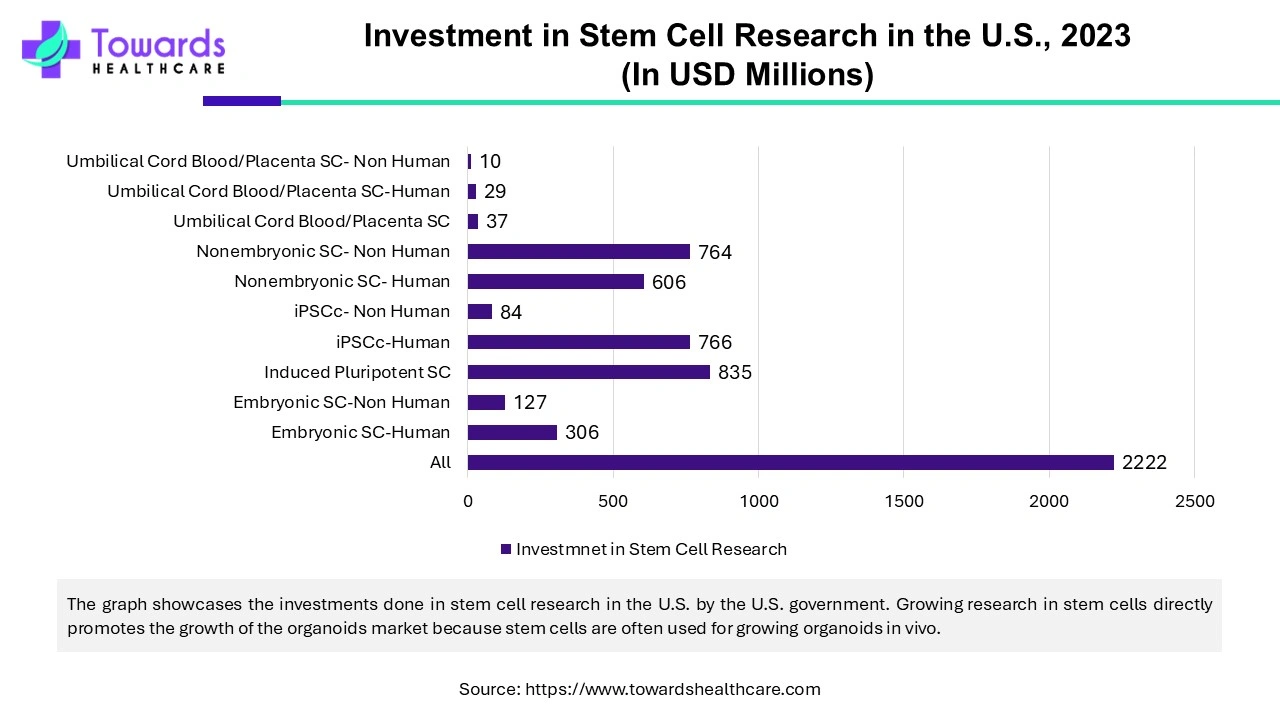November 2025

The global organoids market was estimated at US$ 59 million in 2023 and is projected to grow to US$ 381.7 million by 2034, rising at a compound annual growth rate (CAGR) of 18.5% from 2024 to 2034.

Organoids are simplified and miniaturized organs produced in vitro using scaffolds to mimic the structural function and biological complexity of an organ. Different cells, such as pluripotent stem cells, embryonic cells, tissue, and adult stem cells, are in growing organoids. The organoids market is a composition of products, equipment, research facilities, research and development, and other things that are needed or used in developing and studying organoids. The market’s demand is high due to the application of organoids. Researchers use it in studying the cell cycle, testing new therapeutic drugs, animal development, the function of cells, cell-cell interactions, and many more things that can be used in the future for evidence-based research and healthcare.
Animal testing is a very common practice in healthcare. Drug effects, genetic variation, new procedures, genetic mutations, and all aspects associated with human health are tested on animals before clinical trials are conducted on humans. However, a lot of activists, along with PETA, are against this practice and consider it animal abuse. Many governments are also taking initiatives to stop the use of animal models. In other industries, like makeup, the use of animal models is being banned. However, it will take time to ban animal models in the healthcare industry due to their importance in human safety. With growing R&D in developing more accurate organoids, the use of animal models for testing can be completely mitigated in the future. With highly accurate organoids, the results will be more accurate and useful.
The organoids market faces challenges because the organoids that are now being developed are not highly accurate in comparison to real organs. Due to this, the results achieved using these organoids are not accurate; apart from this, better technology is needed to mimic the real organs, which is, again, a very challenging task.
North America Dominated the organoids market in 2023. The region is growing due to growing research and development associated with organoids and spheroids. The region has advanced infrastructure and technology that provide an advantage to researchers conducting organoids-based research. Countries like the U.S. and Canada majorly contribute to the market’s growth.
The U.S. held the largest share of the organoids market in 2023 due to growing research in oncology and stem cells. The researchers and citizens of the U.S. are highly invested in precision medicine and cancer therapies due to the growing number of cancer patients and rare diseases. The U.S. has institutions like the FDA, National Cancer Institute, National Science Foundation, and others that are significantly contributing to the organoids market.
For instance,
A strong biotechnology and healthcare industry, along with substantial government backing for research and development, have put nations like South Korea, China, and Japan at the forefront of organoid research and application in the Asia Pacific region. The enormous medication manufacturing, increased emphasis on biopharmaceutical R&D, and rise in cancer occurrence in this area all contribute to the organoids market's expansion.
Regarding promoting market expansion, the Indian government is heading in the correct direction. An attempt has been made to replace the use of animals in research, particularly drug testing, with an amendment to the New Drugs and Clinical Trial Rules (2023) that the Indian government adopted in July 2023. The modification allows researchers to replace human-relevant and non-animal methods, including as 3D organoids, organs-on-chip, and advanced computational tools, for assessing the safety and efficacy of new drugs.
Europe is expected to grow significantly in the organoids market during the forecast period. Due to the rising demand for the use of precision medicine, as well as increasing research and development in Europe is rising the demand for the use of organoids is rising. This, in turn, promotes the market growth. The industries are adopting various new technological advancements for the development of new treatment approaches with the help of organoids. Furthermore, the increasing demand for precision medicines contributes to the same. The increasing research and development using organoids is contributing to the market growth.

By type, the stem cell source dominated the organoids market in 2023. The three-dimensional organoid culture created from stem cells has offered new options for regenerative medicine and transplantation. To obtain a more individualized medicine, researchers have merged organoids with tissue engineering technologies to enhance reproducibility, precision in constitution and throughput, and genetic correction.
By type, the tumor cell source is expected to grow at the fastest rate during the forecast period. Tumor organoids may be created in vitro by cultivating tumor cells in malignant effusions, and they can be utilized for medication sensitivity studies in addition to in situ malignancies.
For instance,
By application, the pharmaceutical R&D segment held the largest share of the organoids market in 2023. Pharmaceutical companies use organoids to their full potential. During R&D, pharma companies use organoids to test new drugs or therapeutic products and check their accuracy. It prevents the use of animal models and provides better results. The companies continuously conduct R&D due to the growing demand for therapeutics in the market.
By application, the precision medicine segment is expected to achieve the fastest CAGR during 2024-2034. The application of precise and dependable in vitro and in vivo disease models is an increasingly popular topic of focus in precision medicine. These model systems offer a platform for testing and developing targeted therapeutic medicines in addition to offering insightful information about disease processes and pathology.
By Type
By Application
By Region
November 2025
November 2025
November 2025
November 2025